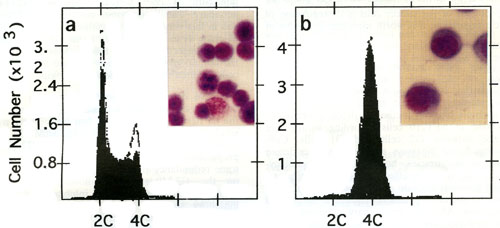tsFT210細胞のG2/M期特異的細胞周期阻害作用の検定
tsFT210細胞のG2/M期特異的細胞周期阻害作用の検定
概要
tsFT210細胞は親株のマウス乳がん細胞FM3A細胞のcdc2キナーゼが温度感受性になった変異株である。そのため許容温度下(32℃)では正常に増殖できるが、非許容温度(39.4℃)ではcdc2キナーゼが不活性型となりG2後期で停止する。G2後期に同調された細胞は許容温度へ戻すことで再びM期をへてG1期へ移行できる。この性質を利用してcdc2キナーゼ阻害剤およびG2期からM期、G1期への移行に関わる因子(プロテインキナーゼ/フォスファターゼ、微小管形成因子など)の阻害剤をスクリーニングする。同調しない細胞への薬剤添加による評価も併せ行っている。
その他:本評価系で活性を発揮する化合物はCdc2の阻害剤およびG2期からM期、G1期進行に関わる因子の阻害剤であることが考えられ、その標的タンパク質の同定は未だ不明な点の多いG2→M→G1期進行メカニズムの解明に貢献することが期待される。
主なヒット天然化合物:
Pironetin, Terpendole E, Cytochalasins, Paclitaxel, Vinblastine

Effects of sangivamycin, RK-1409 and RK-286C on the cell cycle progression from G2- to G1-phase. Asynchronized tsFT210 cells cultured at (a) 32 oC were synchronized at the G2 boundary by incubation at (b) 39 oC for 17 h. The cells were then shifted to 32 oC to release them from G2 arrest. The cells passed through M phase and entered G1 (c) after 4 h. When the cells were simultaneously released from the temperature-arrest in the presence of (d) 10 uM sangivamycin, (e) 0.3 uM RK-1409 and (f) 1.6 uM RK-286C, the cell cycle progression from G2- to M-phase was inhibited. Photographs show morphological characteristics of the corresponding cells observed under the microscope. (Ref:1)
References:
H. Osada, C.-B. Cui, R. Onose, F. Hanaoka.
Screening of cell cycle inhibitors from microbial metabolites by a bioassay using a mouse cdc2 mutant cell line, tsFT210.
Bioorg. Med. Chem., 5, 193-203 (1997).
